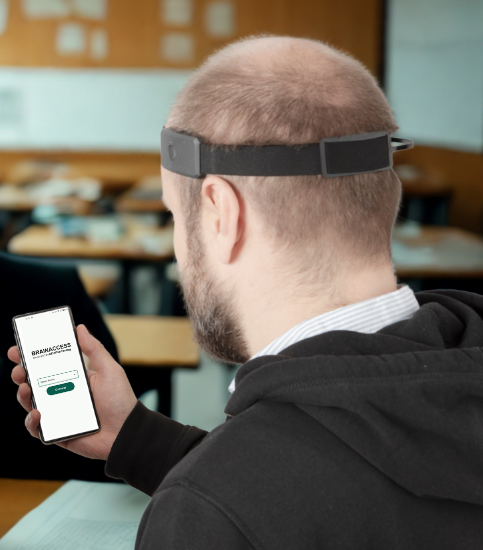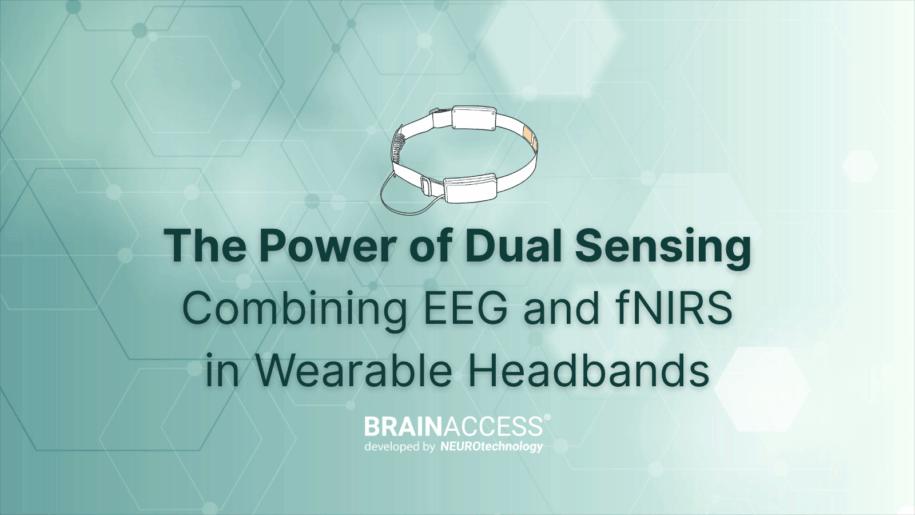The field of neurotechnology is evolving at an extraordinary pace, with wearable devices reshaping the way we study the human brain in natural, everyday settings. As these technologies become increasingly portable, affordable, and user-friendly, researchers can now collect high-quality neural data outside traditional laboratory environments, without the need for bulky equipment or controlled conditions.
Recent progress in sensor design, signal processing, and machine learning has further expanded what is possible, enabling more accurate, multimodal, and context-aware brain monitoring. One of the most exciting directions in this evolution is the integration of electroencephalography (EEG) and functional near-infrared spectroscopy (fNIRS) within a single platform.
Traditionally, EEG-fNIRS setups relied on large, rigid frameworks to accommodate both optical and electrical sensors. This setup is practical for high-density brain mapping but unsuitable for everyday use.
Today, advances in miniaturization and wireless design allow these two modalities to be combined in compact, wearable headbands, capturing complementary electrical and hemodynamic signals in real time and in motion.
So what makes this hybrid approach so powerful?
Understanding EEG and fNIRS
Electroencephalography (EEG) measures voltage fluctuations from neuronal firing on the scalp. It captures millisecond-level changes in brain activity, making it ideal for studying perception, attention, and cognitive workload. EEG is widely used in both research and clinical settings due to its noninvasive nature and relatively low cost.
Functional Near-Infrared Spectroscopy (fNIRS), in contrast, measures light absorption in the near-infrared range to estimate changes in blood oxygenation in the cortex. It reflects slower vascular responses. In other words, how much oxygenated blood a brain region consumes, offering spatial localization of activity. While it lacks the speed of EEG, it provides spatial insights into which cortical areas are active, bridging the gap between brain dynamics and localized function.
In short:
-
EEG → high temporal precision, electrical signals.
-
fNIRS → high spatial insight, blood-based signals.
When used together, EEG and fNIRS allow researchers to capture both the timing and location of neural processes, bridging the gap between fast electrophysiology and slower hemodynamics.
Why Integration matters
The brain’s electrical and vascular responses are tightly linked. When neurons fire, they trigger changes in blood flow and oxygenation, a process known as neurovascular coupling.
By combining EEG and fNIRS, we can capture both sides of this process: the “when” (EEG) and the “where” (fNIRS) of brain activity.
Integrating both sensors into a single device, like modern hybrid EEG-fNIRS systems, offers several key advantages:
Complementary data: simultaneous insights into electrical and hemodynamic activity.
Noise reduction: one modality helps validate and interpret the other, improving signal reliability.
User comfort and mobility: lightweight, wireless designs allow for natural movement and long-term recordings outside the lab.
Scalability: multiple participants can be monitored simultaneously in real-world environments — from classrooms to workplaces.
The Power of a Wireless, Wearable Form Factor
Early EEG-fNIRS studies relied on bulky, discrete systems connected by optical fibers and cables, often limited to laboratory settings.
Such setups suffer from three major issues (Uchitel et al., 2021):
Mechanical complexity. Optical fibers and EEG electrodes compete for scalp space, reducing comfort and wearability.
Synchronization errors. Separate clocks in EEG and fNIRS devices can cause temporal misalignment.
Electrical crosstalk. High-frequency LED drivers in fNIRS modules can interfere with EEG amplifiers.
The hybrid EEG-fNIRS headbands, emerging from new research and commercial development, solve these challenges by merging the two modalities into a single, mechanically and electrically unified system. The most advanced prototypes rely on microchip-based architectures fabricated with Complementary Metal–Oxide–Semiconductor (CMOS) technology (the same technology currently available in smartphones, cameras, and other biomedical sensors), integrating both EEG and fNIRS front-ends on a single chip. (Uchitel et al., 2021)
These designs minimize power consumption, enhance signal-to-noise ratio, and enable lightweight, flexible wearables that can eventually resemble ordinary headbands.
This offers several advantages.
A shared analog-to-digital converters (ADCs) and low-noise electronics improve timing precision.
The simultaneous electrical and hemodynamic measurements reveal neurovascular coupling in real time, allowing for true multimodal recording.
The cross-validation between modalities improves signal reliability, reducing artifacts and noise.
The wireless data transmission, miniaturized optodes, and compact, battery-powered designs allow free movement and extended recording, for a more naturalistic monitoring even during long-term, real-world use.
Finally, using headbands, multiple users could be recorded simultaneously for hyperscanning or social neuroscience, promoting scalability of the experimental design.

Real-World and Research Applications
The move toward wearable, portable brain monitoring opens new frontiers in neuroscience and beyond.
Researchers are no longer confined to lab settings; they can now study cognition in realistic environments, capturing how the brain behaves during everyday activities.
Key applications include:
Neuroergonomics. Tracking mental workload and fatigue in pilots, drivers, or industrial operators.
Education and training. Assessing engagement or attention in real-time classroom environments.
Healthcare and neurorehabilitation. Monitoring stroke recovery, Parkinson’s disease, or anesthesia depth at the bedside.
Brain-computer interfaces (BCIs). Improving command accuracy by combining fast electrical and slower hemodynamic cues.
Mental health and wellness. Enabling stress or mindfulness feedback through physiological signatures of arousal and relaxation.
As integrated circuits, low-power LEDs, and dry electrode technologies advance, these systems are poised to move from research labs to consumer-grade health devices.
Combined with AI and cloud-based analytics, future EEG + fNIRS headbands could deliver real-time insights into cognition, emotion, and brain health.
Non-invasively, comfortably, and anywhere.

What's Next for BrainAccess?
At BrainAccess, we are committed to pushing the boundaries of wearable neurotechnology. Our current EEG headband, the BrainAccess HALO, already deliver high-quality, wireless brain recordings through dry, gold-plated electrodes, combining comfort, portability, and research-grade signal quality.
Building on this foundation, we are now exploring the fNIRS into the HALO platform.
This next-generation design will enable simultaneous monitoring of electrical and hemodynamic activity, opening the door to richer, multimodal insights from a single, lightweight headband. Our goal is to make EEG-fNIRS hybrid sensing truly wearable, affordable, and accessible, empowering researchers, clinicians, and developers to study the brain as it works in the real world.
Stay tuned as more information will disclose in the near future!
Conclusion
Hybrid EEG-fNIRS headbands mark a shift from observing the brain in constrained laboratory setups to monitoring cognition in motion. By merging the precision of EEG with the spatial richness of fNIRS, and wrapping both in a wireless, wearable form factor, they open the door to a new era of brain-aware applications, from scientific discovery to personalized digital health.
Reference
Uchitel, J., Vidal-Rosas, E. E., Cooper, R. J., & Zhao, H. (2021). Wearable, integrated eeg–fnirs technologies: A review. Sensors, 21(18), 6106. https://doi.org/10.3390/s21186106


